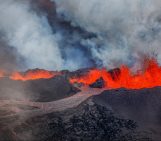
Following the impact of the global plate kinematics revolution, researchers in the 70s and 80s made significant efforts to compare records of deformed rocks in outcrops to large-scale deformation and kinematics. By publishing “S-C Mylonites” 1984, Gordon A. Lister and Arthur W. Snoke gave a step forward for the TS community. The paper contributed to transitioning from a strain-dominated framework of interpreting fabrics at all scales (Ramsay, 1967) towards a kinematics-dominated one. The article recapitulated the rock deformation processes and illustrated how specific aspects of the mylonitic foliation develop in intense non-coaxial laminar flow zones.
Lister and Snoke authors introduced the term type II S-C mylonites and proposed a broad class of S-C tectonites. They also posed the problem of the timing of the S foliation and the C fabric (see also Platt et al., 1980, and Berthé et al., 1979). In many deformed rocks, the foliation is considered close to a shear plane. However, the dominant foliation S (french “schistosité”) in “type 1” mylonites is not a plane of shear strain but the principal plane of strain, at a slight angle to the plane of high shear strain, called C (french “cisaillement”). The paper proposed that the kinematic framework fundamentally influences microstructural evolution, supported by interpretations of CPO (crystal preferred orientation) fabrics.
A possible controversy of this work is that the common way to draw kinematic diagrams with shear sense arrows parallel to the foliation can be misleading: is foliation a result of rotation and pressure solution? or is there a shear strain parallel to the foliation as seems to be the case sometimes? Moreover, several authors seem to prefer to avoid the term “shear bands” while talking about C-type shear planes in originally isotropic rocks (like granite protolith).

Fig. 1. Snapshot of the 3D model of a sample orthogneiss with S-C mylonites from Bretagne that you can find here. (A) planes xy and yz bove of the sample; (B) Visualisation of the xz plane of the ellipse of the finite strain; (C) Trajectories of the axis of principal finite extension in a type I S-C mylonite. Shear bands transect a mylonitic foliation S (modified after Lister and Snoke, 1984).
Where do we go now in the TS community with kinematics and fabrics in deformed rocks? Here there are some insights:
- Numerical and experimental simulations and new techniques of image processing.
- Theoretical kinematics investigations of serpentine- and clay-rich rocks common in shear zones where fluids circulate (beyond the kinematic investigations in qz-feldspathic, with micas or olivine-rich, e.g., Gapais, 1989; Précigout et al., 2013).
- Integration of geochronological techniques to structural studies directly targeting mica-rich fabric can help determine foliation and shear bands ages. With detailed petrographic description, even pauses in deformation can be found and dated (see DSD, deformation sequence diagram, Beltrando et al., 2007).
- Improved understanding of the mechanics of earthquakes, e.g., correlation of co-seismic structures to simple deformational mechanisms (see description of the condition for such deformation using coulomb plastic deformation, Byerlee and Savage, 1992).
In the discussion on the Reddit forum, there are contributions by Philippe Gonçalves and Gordon Lister. A beautiful 3D sample from the original palace where the “type I” S-C mylonites were first described can be checked here. Lister announced the creation of a digital library permitting a colour visualization of the samples described in this article.
Adriana Guatame-García, Utsav Mannu, Gianluca Frasca and the TS Must Read team
References
Beltrando, M., Hermann, J., Lister, G., & Compagnoni, R. (2007). On the evolution of orogens: Pressure cycles and deformation mode switches. Earth and Planetary Science Letters, 256(3–4), 372–388. https://doi.org/10.1016/j.epsl.2007.01.022
Berthé, D., Choukroune, P., & Jegouzo, P. (1979). Orthogneiss, mylonite and non-coaxial deformation of granites: the example of the South Armorican Shear Zone. Journal of Structural Geology, 1(1), 31–42. https://doi.org/10.1016/0191-8141(79)90019-1
Byerlee, J. D., & Savage, J. C. (1992). Coulomb plasticity within the fault zone. Geophysical Research Letters, 19(23), 2341-2344. https://doi.org/10.1029/92GL02370
Gapais, D. (1989). Shear structures within deformed granites: mechanical and thermal indicators. Geology, 17(12), 1144–1147. https://doi.org/10.1130/0091-7613(1989)017<1144:SSWDGM>2.3.CO;2
Lister, G. S., & Snoke, A. W. (1984). SC mylonites. Journal of Structural Geology, 6(6), 617–638. https://doi.org/10.1016/0191-8141(84)90001-4
Platt, J. P., & Vissers, R. L. M. (1980). Extensional structures in anisotropic rocks. Journal of Structural Geology, 2(4), 397–410. https://doi.org/10.1016/0191-8141(80)90002-4
Précigout, J., Gueydan, F., Garrido, C. J., Cogné, N., & Booth-Rea, G. (2013). Deformation and exhumation of the Ronda peridotite (Spain). Tectonics, 32(4), 1011–1025. https://doi.org/10.1002/tect.20062
Ramsay, J. G. (1967). Folding and fracturing of rocks. Mc Graw Hill Book Company, 568 pp.




